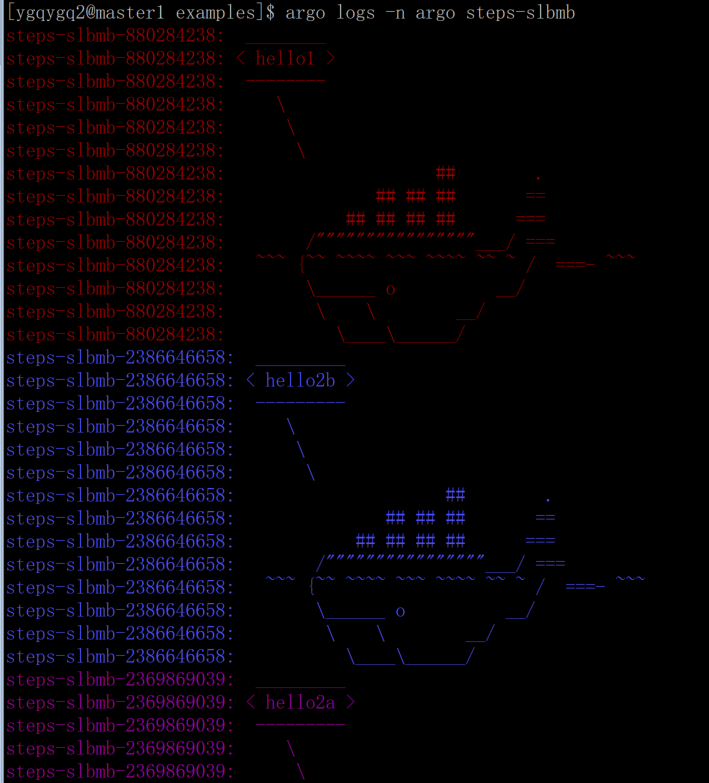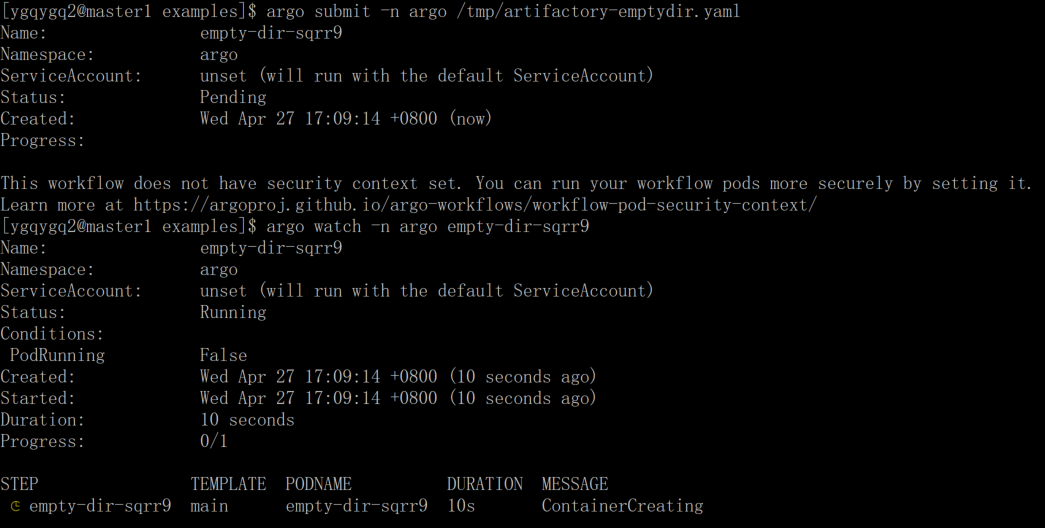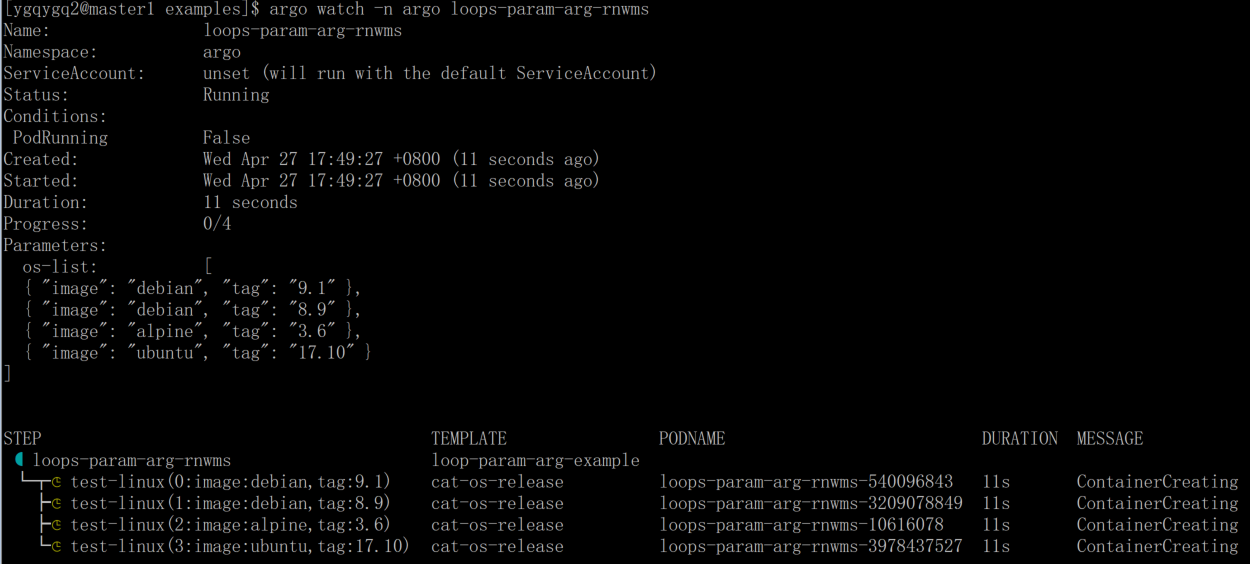1. Argo Workflows 简单介绍
Argo Workflows 是一个开源容器化原生工作流引擎,用于在 Kubernetes 中编排并行作业。Argo Workflows 实现为一个 Kubernetes CRD (自定义资源定义)。 其详细介绍和核心概念等查看官方文档即可,本文通过示例来体验 Argo Workflows。
2. Argo Workflows 安装
我使用 helm 安装 bitnami 的 charts 仓库中的 argo-workflows。安装过程略...
3. 官方示例体验
我们使用官方示例测试
3.1 CLI 安装
根据自己的环境,安装相应的 CLI。 https://github.com/argoproj/argo-workflows/releases
3.2 示例体验并简单总结
3.2.1 hello world
argo submit hello-world.yaml
argo list
argo get hello-world-xxx
argo logs hello-world-xxx
argo delete hello-world-xxx
argo submit hello-world.yaml -n argo
argo watch -n argo hello-world-59rtg
apiVersion: argoproj.io/v1alpha1
kind: Workflow
metadata:
generateName: hello-world-
labels:
workflows.argoproj.io/archive-strategy: 'false'
annotations:
workflows.argoproj.io/description: |
This is a simple hello world example.
You can also run it in Python: https://couler-proj.github.io/couler/examples/#hello-world
spec:
entrypoint: whalesay
templates:
- name: whalesay
container:
image: docker/whalesay:latest
command: [cowsay]
args: ['hello world']


argo 命令用起来参考了 kubectl 的习惯,还是非常丝滑的;argo 使用 submit 子命令创建 Workflow ;- Workflow 资源显示非常详细,包含运行状态、所用资源、运行时间等;
3.2.2 Parameters
argo submit arguments-parameters.yaml -p message="ygqygq2 is testing argo workflows" -n argo
argo watch -n argo arguments-parameters-fnbpl
apiVersion: argoproj.io/v1alpha1
kind: Workflow
metadata:
generateName: arguments-parameters-
spec:
entrypoint: whalesay
arguments:
parameters:
- name: message
value: hello world
templates:
- name: whalesay
inputs:
parameters:
- name: message
container:
image: docker/whalesay:latest
command: [cowsay]
args: ['{{inputs.parameters.message}}']


argo logs -n argo arguments-parameters-fnbpl
全局参数
argo submit -n argo global-parameters.yaml -p message="ygqygq2 is testing workflows"
argo logs -n argo global-parameters-jhwqj
apiVersion: argoproj.io/v1alpha1
kind: Workflow
metadata:
generateName: global-parameters-
spec:
entrypoint: whalesay1
arguments:
parameters:
- name: message
value: hello world
templates:
- name: whalesay1
container:
image: docker/whalesay:latest
command: [cowsay]
args: ['{{workflow.parameters.message}}']

argo 通过 -p key=value 方式传递参数给 Workflow 的容器,Workflow 中使用 args: ["{{inputs.parameters.message}}"] 接收参数;--parameter-file params.yaml 参数构建可以指定 YAML 或 JSON 格式参数文件;{{workflow.parameters.message}} 这种方式 workflow 全局参数 message;
3.2.3 Steps
多步骤 workflow
argo submit steps.yaml -n argo
argo watch -n argo steps-slbmb
apiVersion: argoproj.io/v1alpha1
kind: Workflow
metadata:
generateName: steps-
spec:
entrypoint: hello-hello-hello
templates:
- name: hello-hello-hello
steps:
- - name: hello1
template: whalesay
arguments:
parameters: [{ name: message, value: 'hello1' }]
- - name: hello2a
template: whalesay
arguments:
parameters: [{ name: message, value: 'hello2a' }]
- name: hello2b
template: whalesay
arguments:
parameters: [{ name: message, value: 'hello2b' }]
- name: whalesay
inputs:
parameters:
- name: message
container:
image: docker/whalesay
command: [cowsay]
args: ['{{inputs.parameters.message}}']




argo logs -n argo steps-slbmb

- 可以看到 hello1、hello2a 是串行关系;
- hello2a、hello2b 是并行关系;
argo log 可以看到不同 pod 的输出不同颜色,这点体验不错;
3.2.4 DAG(directed-acyclic graph)
在下面工作流中,步骤 A B 同时运行,因为它们不依赖其它步骤,步骤 C 依赖 A,步骤 D 依赖 A 和 B,它们的依赖步骤运行完成,才会开始。 
argo submit -n argo dag-multiroot.yaml
argo watch -n argo dag-multiroot-z4zzz
apiVersion: argoproj.io/v1alpha1
kind: Workflow
metadata:
generateName: dag-multiroot-
spec:
entrypoint: multiroot
templates:
- name: echo
inputs:
parameters:
- name: message
container:
image: alpine:3.7
command: [echo, '{{inputs.parameters.message}}']
- name: multiroot
dag:
tasks:
- name: A
template: echo
arguments:
parameters: [{ name: message, value: A }]
- name: B
template: echo
arguments:
parameters: [{ name: message, value: B }]
- name: C
depends: 'A'
template: echo
arguments:
parameters: [{ name: message, value: C }]
- name: D
depends: 'A && B'
template: echo
arguments:
parameters: [{ name: message, value: D }]



argo logs -n argo dag-multiroot-z4zzz

非 FailFast
argo submit -n argo dag-disable-failFast.yaml
argo watch -n argo dag-primay-branch-jdg6l
apiVersion: argoproj.io/v1alpha1
kind: Workflow
metadata:
generateName: dag-primay-branch-
spec:
entrypoint: statis
templates:
- name: a
container:
image: docker/whalesay:latest
command: [cowsay]
args: ['hello world']
- name: b
retryStrategy:
limit: '2'
container:
image: alpine:latest
command: [sh, -c]
args: ['sleep 30; echo haha']
- name: c
retryStrategy:
limit: '3'
container:
image: alpine:latest
command: [sh, -c]
args: ['echo intentional failure; exit 2']
- name: d
container:
image: docker/whalesay:latest
command: [cowsay]
args: ['hello world']
- name: statis
dag:
failFast: false
tasks:
- name: A
template: a
- name: B
depends: 'A'
template: b
- name: C
depends: 'A'
template: c
- name: D
depends: 'B'
template: d
- name: E
depends: 'D'
template: d
FailFast false 示例:dag-disable-failFast.yaml
apiVersion: argoproj.io/v1alpha1
kind: Workflow
metadata:
generateName: dag-primay-branch-
spec:
entrypoint: statis
templates:
- name: a
container:
image: docker/whalesay:latest
command: [cowsay]
args: ['hello world']
- name: b
retryStrategy:
limit: '2'
container:
image: alpine:latest
command: [sh, -c]
args: ['sleep 30; echo haha']
- name: c
retryStrategy:
limit: '3'
container:
image: alpine:latest
command: [sh, -c]
args: ['echo intentional failure; exit 2']
- name: d
container:
image: docker/whalesay:latest
command: [cowsay]
args: ['hello world']
- name: statis
dag:
failFast: false
tasks:
- name: A
template: a
- name: B
depends: 'A'
template: b
- name: C
depends: 'A'
template: c
- name: D
depends: 'B'
template: d
- name: E
depends: 'D'
template: d






argo logs -n argo dag-primay-branch-jdg6l

- DAG 默认 FailFast 设置为
true,即一旦有步骤失败,它将停止调度后面的步骤,只等待正在运行的步骤完成;
- 如果将 FailFast 设置为
false,它将不管步骤运行结果,继续调度后面步骤,直至所有步骤运行完成;
3.2.5 Artifacts
配置制品库参考:https://argoproj.github.io/argo-workflows/configure-artifact-repository/ 支持 Minio、AWS s3、GCS、阿里 OSS
argo submit -n argo artifact-repository-ref.yaml
当前官方示例报错,它建议使用 emptyDir 
我们根据官方 emptyDir 示例 继续
argo submit -n argo /tmp/artifactory-emptydir.yaml
argo watch -n argo empty-dir-sqrr9
apiVersion: argoproj.io/v1alpha1
kind: Workflow
metadata:
generateName: empty-dir-
spec:
entrypoint: main
templates:
- name: main
container:
image: argoproj/argosay:v2
command: [sh, -c]
args: ['cowsay hello world | tee /mnt/out/hello_world.txt']
volumeMounts:
- name: out
mountPath: /mnt/out
volumes:
- name: out
emptyDir: {}
outputs:
parameters:
- name: message
valueFrom:
path: /mnt/out/hello_world.txt


- 当前 k8s 不允许 workflow 直接输出制品在目录或文件中,须使用 emptyDir 或 pvc 等;
- 制品默认被打包为 Tarballs,默认情况下是 gzipped。可以通过使用归档字段指定归档策略来自定义此行为;
3.2.6 The Structure of Workflow Specs
Workflow 基本结构:
- 包含元数据的 kubernetes 头部
- Spec 主体
- 对于每个模板定义
- 容器调用或步骤列表
总而言之,Workflow 规范是由一组 Argo 模板组成的,其中每个模板包含一个可选的输入部分,一个可选的输出部分,以及一个容器调用或者一个步骤列表,其中每个步骤调用另一个模板。
注意,Workflow 规范的容器部分将接受与 pod 规范的容器部分相同的选项,包括但不限于环境变量、secret、volume、挂载。因此本文不在赘述相关 kubernetes 资源在 workflow 中的使用。
3.2.7 Scripts & Results
使用脚本获取运行结果
argo submit -n argo scripts-bash.yaml
argo watch -n argo scripts-bash-4fcm8
apiVersion: argoproj.io/v1alpha1
kind: Workflow
metadata:
generateName: scripts-bash-
spec:
entrypoint: bash-script-example
templates:
- name: bash-script-example
steps:
- - name: generate
template: gen-random-int
- - name: print
template: print-message
arguments:
parameters:
- name: message
value: '{{steps.generate.outputs.result}}'
- name: gen-random-int
script:
image: debian:9.4
command: [bash]
source: |
cat /dev/urandom | od -N2 -An -i | awk -v f=1 -v r=100 '{printf "%i\n", f + r * $1 / 65536}'
- name: print-message
inputs:
parameters:
- name: message
container:
image: alpine:latest
command: [sh, -c]
args: ['echo result was: {{inputs.parameters.message}}']

argo logs -n argo scripts-bash-4fcm8

script 关键字允许使用 source 来定义脚本主体,这将创建一个包含脚本主体的临时文件,然后将临时文件的名称作为最后一个参数传递给 command,command应该是一个脚本解释器;- 使用
script 我特性还将运行脚本的标准输出指定给一个名为 result的特殊输出参数。这允许您在 workflow 的其余部分中使用脚本运行结果,在上面示例中,结果只是由 print-message 模板回显。
3.2.8 Output Parameters
输出参数提供了将步骤的结果作为参数而不是作为工件使用的通用机制。这允许您将任何类型的步骤(而不仅仅是script)的结果用于条件测试、循环和参数。输出参数的工作方式与 script result类似,只是输出参数的值设置为生成文件的内容,而不是标准输出的内容。
3.2.9 Loops
循环
argo submit -n argo loops-param-argument.yaml
argo watch -n argo loops-param-arg-rnwms
apiVersion: argoproj.io/v1alpha1
kind: Workflow
metadata:
generateName: loops-param-arg-
spec:
entrypoint: loop-param-arg-example
arguments:
parameters:
- name: os-list
value: |
[
{ "image": "debian", "tag": "9.1" },
{ "image": "debian", "tag": "8.9" },
{ "image": "alpine", "tag": "3.6" },
{ "image": "ubuntu", "tag": "17.10" }
]
templates:
- name: loop-param-arg-example
inputs:
parameters:
- name: os-list
steps:
- - name: test-linux
template: cat-os-release
arguments:
parameters:
- name: image
value: '{{item.image}}'
- name: tag
value: '{{item.tag}}'
withParam: '{{inputs.parameters.os-list}}'
- name: cat-os-release
inputs:
parameters:
- name: image
- name: tag
container:
image: '{{inputs.parameters.image}}:{{inputs.parameters.tag}}'
command: [cat]
args: [/etc/os-release]




- workflow 支持循环的使用,不止是单个步骤,也支持多步骤中使用循环;
- 可以使用列表作为参数传递;
- 也可以动态生成要迭代的列表项;
3.2.10 Conditionals
Workflow 支持条件执行,语法是通过 govaluate实现的,它为复杂的语法提供了支持。
argo submit -n argo conditionals-complex.yaml
argo watch -n argo coinflip-8zsc2
apiVersion: argoproj.io/v1alpha1
kind: Workflow
metadata:
generateName: coinflip-
spec:
entrypoint: coinflip
templates:
- name: coinflip
steps:
- - name: flip-coin
template: flip-coin
- - name: heads
template: heads
when: '{{steps.flip-coin.outputs.result}} == heads'
- name: tails
template: tails
when: '{{steps.flip-coin.outputs.result}} == tails'
- - name: flip-again
template: flip-coin
- - name: complex-condition
template: heads-tails-or-twice-tails
when: >-
( {{steps.flip-coin.outputs.result}} == heads &&
{{steps.flip-again.outputs.result}} == tails
) ||
( {{steps.flip-coin.outputs.result}} == tails &&
{{steps.flip-again.outputs.result}} == tails )
- name: heads-regex
template: heads
when: '{{steps.flip-again.outputs.result}} =~ hea'
- name: tails-regex
template: tails
when: '{{steps.flip-again.outputs.result}} =~ tai'
- name: flip-coin
script:
image: python:alpine3.6
command: [python]
source: |
import random
result = "heads" if random.randint(0,1) == 0 else "tails"
print(result)
- name: heads
container:
image: alpine:3.6
command: [sh, -c]
args: ['echo "it was heads"']
- name: tails
container:
image: alpine:3.6
command: [sh, -c]
args: ['echo "it was tails"']
- name: heads-tails-or-twice-tails
container:
image: alpine:3.6
command: [sh, -c]
args:
['echo "it was heads the first flip and tails the second. Or it was two times tails."']


3.2.11 Recursion
递归
argo submit -n argo coinflip-recursive.yaml
argo watch -n argo coinflip-recursive-5c96n
apiVersion: argoproj.io/v1alpha1
kind: Workflow
metadata:
generateName: coinflip-recursive-
spec:
entrypoint: coinflip
templates:
- name: coinflip
steps:
- - name: flip-coin
template: flip-coin
- - name: heads
template: heads
when: '{{steps.flip-coin.outputs.result}} == heads'
- name: tails
template: coinflip
when: '{{steps.flip-coin.outputs.result}} == tails'
- name: flip-coin
script:
image: python:alpine3.6
command: [python]
source: |
import random
result = "heads" if random.randint(0,1) == 0 else "tails"
print(result)
- name: heads
container:
image: alpine:3.6
command: [sh, -c]
args: ['echo "it was heads"']


- 直到达成某个条件,workflow 才会跳出递归,然后结束;
- 和程序员开发过程中写循环一样,设定是否能正常退出递归的条件尤为关键,否则将会一直创建 POD 执行任务,直到超时或干预停止 workflow;
3.2.12 Exit handlers
退出处理程序是一个总是在工作流结束时执行的模板,无论成功还是失败。 退出处理程序的一些常见用例如下:
- 工作流程运行后的清理工作
- 发送工作流状态通知(例如,电子邮件/Slack)
- 将通过/失败状态发布到 webhook 结果(例如 GitHub 构建结果)
- 重新提交或提交另一个工作流
argo submit -n argo exit-handlers.yaml
argo watch -n argo exit-handlers-77kvs
apiVersion: argoproj.io/v1alpha1
kind: Workflow
metadata:
generateName: exit-handlers-
spec:
entrypoint: intentional-fail
onExit: exit-handler
templates:
- name: intentional-fail
container:
image: alpine:latest
command: [sh, -c]
args: ['echo intentional failure; exit 1']
- name: exit-handler
steps:
- - name: notify
template: send-email
- name: celebrate
template: celebrate
when: '{{workflow.status}} == Succeeded'
- name: cry
template: cry
when: '{{workflow.status}} != Succeeded'
- name: send-email
container:
image: alpine:latest
command: [sh, -c]
args:
[
'echo send e-mail: {{workflow.name}} {{workflow.status}} {{workflow.duration}}. Failed steps {{workflow.failures}}',
]
- name: celebrate
container:
image: alpine:latest
command: [sh, -c]
args: ['echo hooray!']
- name: cry
container:
image: alpine:latest
command: [sh, -c]
args: ['echo boohoo!']



4. 小结
其它的一些功能和示例,这里不再展开。使用时多查看官方文档,多试验,就会越发了解 argo workflows; 当前可能配合 jenkins 这类 CI/CD 工具一起使用效果比较好; 整体使用下来,感受到 Argo Workflows 的强大功能,也希望未来将会越来越好,随着其功能的逐渐完善,期待其成为 kubernetes 中 CI/CD 的标杆。
参考资料: [1] https://argoproj.github.io/argo-workflows/ [2] https://github.com/argoproj/argo-workflows/blob/master/examples/README.md






































评论